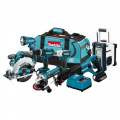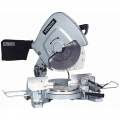 |
| From top to bottom: Spade, lip and spur (brad point), masonry bit and twist drill bits |
Drill bits are cutting tools used to create cylindrical holes. Bits are held in a tool called a drill , which rotates them and provides torque and axial force to create the hole. Specialized bits are also available for non-cylindrical-shaped holes.
 |
| Drill bit (upper left), mounted on a pistol-grip corded drill |
The shank is the part of the drill bit grasped by the chuck of a drill. The cutting edges of the drill bit are at one end and the shank is at the other.
Drill bit come in standard sizes , described in the drill bit sizes article. A comprehensive drill bit and tap size chart lists metric and imperial sized drill bits alongside the required screw tap sizes.
The term drill may refer to either a drilling machine or a drill bit for use in a drilling machine. In this article , for clarity , drill bit or bit is used throughout to refer to a bit for use in a drilling machine and drill refer always to a drilling machine.





